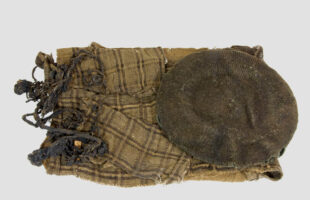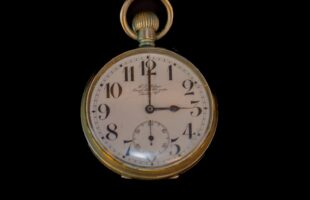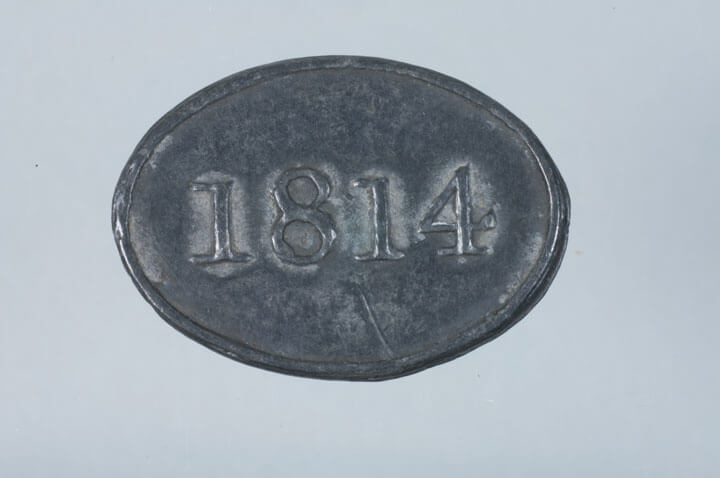Our Collections
Social History

Our Social History collection tells the story of Orkney from its transfer to Scotland in the 15th century to the present day. It shows how life was led by the rich and poor, agricultural improvements and the development of industry.
Two World Wars saw Scapa Flow as a major naval base, while the scuttling and salvage of the German Fleet there has left a large number of artefacts, which is of international importance

Leather Boot
This leather boot upper was discovered during the renovations to turn Tankerness House into the county museum in 1965.
Leather Boot

Museum Location: Orkney Museum
Date: Unknown
Period: Medieval
Size: 235mm x 155m
Accession Number: 1998.132
Summary: The land reclaimed behind Broad Street where the museum stands was thought to have been reclaimed sometime in the 19th century, based on late 18th century drawings which show the tide still coming up to the back of the buildings. By 1930, the shoreline looks much as it does today. The boot was found 5 feet below ground level, at the level of the original beach. Its exact date is unconfirmed but it's thought to date from the late medieval period.
Object Description: This leather boot upper was discovered during the renovations to turn Tankerness House into the county museum in 1965.

Huntsgarth Clothing
The Huntsgarth clothing was found in a peat bog in Harray in 1968 by Mr George Spence
Huntsgarth Clothing

Museum Location: Orkney Museum
Period: 18th Century
Accession Number: 1979.023
Summary: The clothes are the only remaining evidence of the burial of a child in the bog, thought to have been around 3 or 4 years old. There was never any chemical evidence of there having been a body, but research proffers that the nature of the folds in the garment and fine strands of blond hair found on the cloth indicate that a body had been there. Curiously a man’s bonnet was placed over the clothing, and the reason for this has never been ascertained. The bonnet was dated to be 18th century, however the dress had clearly been something else in its life and repurposed into a garment for the child. No exact date has ever been allocated.
Object description: The Huntsgarth clothing was found in a peat bog in Harray in 1968 by Mr George Spence when he was digging peats.

Nursing Chair with the initials E.T from 1596
Gifted by James Tait of Cannigal to his daughter Ellen Tait on the event of her marriage to James Drever of Westray in 1596.
Chair, Nursing

Museum Location: Orkney Museum
Date: circa 1596
Period: 16th Century
Size: Back post 762mm, Seat length 452mm, Front Legs 337mm
Accession Number: 1997.211
Summary: Most commonly found in Victorian homes, nursing chairs are traditionally smaller pieces of furniture which would place the user closer to the ground, which would help with easier interactions with young children and breastfeeding.
Object description: Gifted by James Tait of Cannigal to his daughter Ellen Tait on the event of her marriage to James Drever of Westray in 1596. It remained in the Drever family until it was bequeathed to Orkney Museum in 1997.

Bog Cotton Christening socks
Christening socks made for John Robert Hourston, born in Tankerness on 29th July 1907.
Bog Cotton Christening socks

Museum Location: Orkney Museum
Date: circa 1907
Period: 20th Century
Size: 280mm length x 95mm at widest part
Accession Number: 2016.018
Summary: Often found in bogs, Eriophorum angustfolium,commonly know as 'common cottongrass' produce seed heads hat resemble cotton tufts. This fact and being commonly found in bogs has led to the common name of 'Bog Cotton' for the textile produced from it. The Great Exhibition of 1851 describes bog cotton as being used like commercial cotton to make thread and cloth, "garments woven by crofting women...much admired for their beauty and fine texture"
Object description: These were made for John Robert Hourston, born in Tankerness on 29th July 1907. They had been made from yarn hand-spun from wild bog cotton (known locally as Lucky Minnie’s Oo) by Mary Ann Cooper, born in Stronsay in 1882, who learnt to spin and knit as a child. She met John’s mother, Isabella Wright, when her family moved to Tankerness and they lived in the same area for the rest of their lives. The socks were donated to Orkney Musuem in 2016.

Cigarette Case and New Testament
Chromium plated cigarette case and accompanying New Testament, carried around in the breast pocket of Private John G. Johnston.
Cigarette Case and New Testament

Museum Location: Orkney Museum
Date: Unknown
Period: 20th Century
Size: 90mmx 85mmx10mm
Accession Number: 1997.049.1
Summary: Chromium plated cigarette case and accompanying New Testament, carried around in the breast pocket of Private John G. Johnston.
Object description: Orcadian Private John G. Johnston was shot in the chest as he parachuted into Hamminkeln, Germany on the 24th March 1945. It was only thanks to the presence of the cigarette case and New Testament tucked into his breast pocket that he survived. The bullet blew an explosive hole straight through the cigarette box, but got no further thanks to his copy of the New Testament which acted as a buffer, and only received a small dent in its leather cover.

Tom Kent Camera
Whole Plate Camera owned and used by Orcadian photographer Tom Kent.
Camera

Museum Location: Orkney Museum
Date: circa. 1886
Period: 20th Century
Size: Tripod 840mm, Body: Length 26mm, height 286mm, Breadth 250mm
Accession Number: 1976.205
Summary: Plate cameras are named after the film that they used and in this case they used photographic-sensitive metal plates. However, these metal plates were phased out for glass equivalents which are more commonly found in collections today.
Object description: This camera, among a collection others from Tom Kent ownership was donated to the museum in 1976.

Signatures of some of the survivors of HMS Royal Oak
Signatures obtained on this handkerchief by Mrs Roberta Robinson (nee MacLeod) of some of the survivors of HMS Royal Oak
Handkerchief with Signatures of HMS Royal Oak Survivors

Museum Location: Scapa Flow
Date: 1939
Period: 20th Century
Size: 480mm x 480mm
Accession Number: 2022.003
Summary: HMS Royal Oak sank in the early hours of October 14th 1939, claiming the lives of 835 boys and men. Robert Gatt, the skipper of the tender Daisy II was responsible for having rescued almost all of the survivors, pulling 386 people out of the water. In total, only 424 people survived the disaster.
Object Description: In the immediate aftermath of the sinking of the HMS Royal Oak, some of the survivors were taken to the Thurso Town Hall and Salvation Army Canteen to be cared for until they could travel home. To commemorate the occasion, Mrs Roberta Robertson (nee MacLeod) obtained their signatures on this handkerchief. The handkerchief was cared for by several families before being donated to Orkney Museums in 2022

German WW1 Pocket watch
This German officer’s pocket watch was acquired by a British sailor when he was stationed in Scapa Flow during the scuttling of the German Fleet
German WW1 Pocket watch

Museum Location: Scapa Flow Museum
Date: circa. 1905
Period: 20th Century
Size: 65mm diameter, 20mm thick
Accession Number: 2022.012
Summary: When the German High Seas Fleet was scuttled in Scapa Flow on 21st June 1919, many items were acquired from these ships at the time of the scuttling, through salvage efforts and afterwards when some were re-floated and taken to be broken up. Orkney Museum and Stromness Museum have both been recipients of many of these finds over the years.
Object Description: This German officer’s pocket watch was acquired by a British sailor when he was stationed in Scapa Flow during the scuttling of the German Fleet. It is not known exactly how he came to have it but he went on to use the watch constantly throughout the years following the war until his death, when it passed to his son and then grandson, by which time it had ceased to be operational. At some point the original glass front must have broken, as a more modern plastic one is in place today.

Ba'
This Ba' was won by Barbara Yule, on Christmas Day 1945 and donated to Orkney Museum by her family in 1999.
Ba'

Museum Location: Orkney Museum
Date: 1945
Period: 20th Century
Size: Height 190mm, Central circumference 628mm
Accession Number: 2000.176
Summary: The Ba' has been played in Orkney since around 1650, but evidence suggests that it dates back far further than this. It was always a predominantly male game until Christmas 1945. After World War II the women demanded their own Ba’ game. It was greeted with hostility from the men, but amazingly it went ahead. The women were "allowed" to play a further game in the New Year of 1946, but this was to be the last. Men protested that it was unladylike, and women were banned from playing the game.
Objective Description: This Ba' was won by Barbara Yule, on Christmas Day 1945. Scarcity of materials meant that old Ba’s had to be used for play for until 1952. This Ba’ was originally won by Andrew Shearer for the Uppies on Christmas Day 1934. For him to donate his treasured Ba’ for a women’s game showed that not all men were opposed to women playing.

Pewter communion token from Graemsay and Hoy
Communion token issued to members of the congregation to provide them access to the Lord’s supper.
Church Token

Museum Location: Orkney Museum
Date: 1814
Period: 19th Century
Size: 29mm x 20mm
Accession Number: 1984.223
Summary: First suggested in 1560, communion tokens were issued to members of the congregation to provide them access to the Lord’s supper. Decisions as to who would receive the token would have been made by the minister and/or church elders, based on the apparent character or presentation of a member of the community. If a person wasn’t deemed worthy, or had displayed recent real or perceived bad behaviour, then no token would be offered. These tokens were being phased out towards the end of the 19th century, to be replaced with communion cards.
Object description: It is likely that this object came from the Orkney Antiquarian Society's collection which had been in store at the Old Library on Laing Street, Kirkwall since 1939 when the society permanently disbanded. Artefacts were later transferred into the care of the the museum ahead of their opening in 1968. Most came without any supporting documentation.

Straw Orkney Chair
Orkney Straw Chair

Museum Location: Orkney Museum
Period: 19th Century
Size: Height 750mm
Accession Number: 1976.196
Object description:
Made of straw except for a crosspiece of wood strengthening the base with small wooden feet attached; iron pins attach this crosspiece at each corner to the straw; slivers of wood strengthen the arms, back & seat - pushed into the woven straw with only the ends visible.

Norwegian Yacht Armrest
Norwegian Yacht Armrest

Museum Location: Orkney Museum
Period: 20th Century
Accession Number: 1992.015.1-3
Object description:
Armrest taken from the Norwegian Yacht SOLI in which Norwegians crossed from Norway to Orkney (Deerness) during the German occupation in August 1941.
